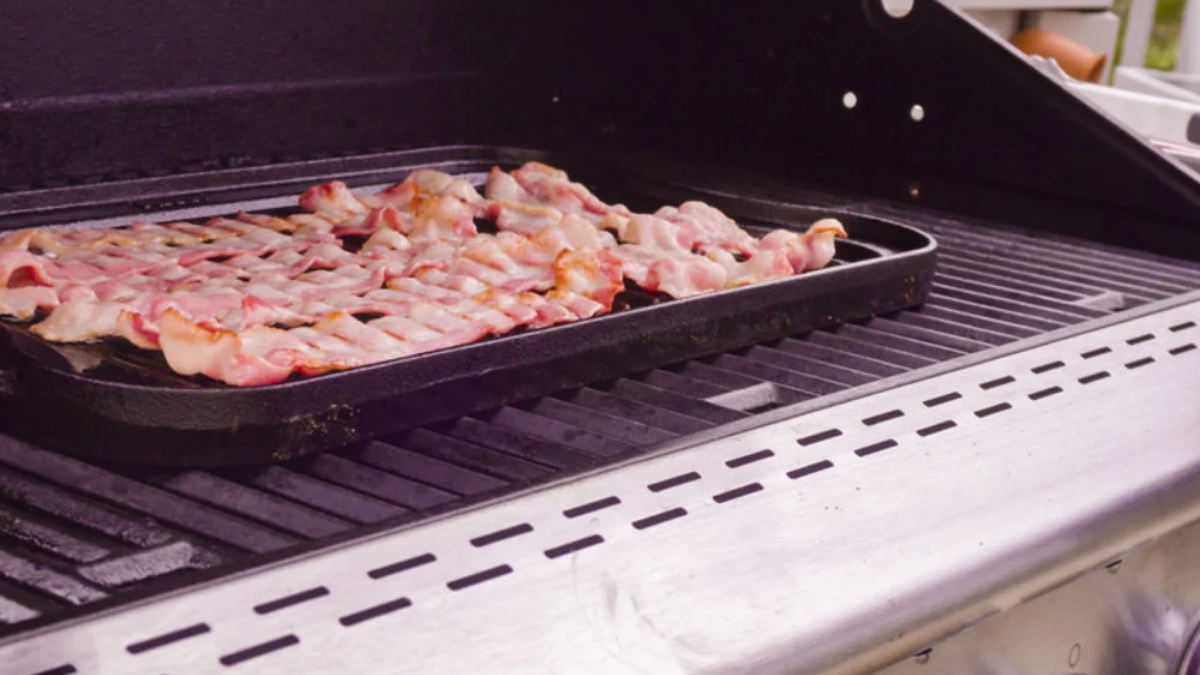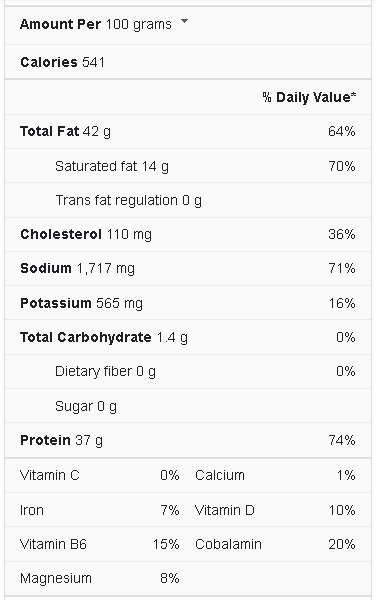Is it possible to Cook Bacon on the grill? Yes, if done correctly. But you can’t just throw strips of Bacon on a hot grill; the bacon fat will render in dramatic flare-ups. You’ll have burnt Bacon or, even worse, bacon ash. Grilled Bacon is smoky, flavorful, and just the right amount of crispy when done correctly. Once you’ve perfected the skill of grilling Bacon, you’ll be able to savor the unparalleled flavor of Bacon grilled in the great outdoors whenever the mood strikes. Read on for our grilling bacon secrets and tips, and prepare for a whole new level of smoky goodness!
You can use standard, center-cut, or thick-sliced Bacon when cooking the Bacon over indirect heat. We prefer thick-sliced Bacon for direct-heat cooking, and the savory strips will cook more evenly, and thicker slices will be simpler to turn and less likely to fall through the grill grates. A pound of standard sliced Bacon usually contains between 16 and 20 slices, to give you an idea.
Bacon Nutrition Facts
How to Grill Bacon?
Smoky, crunchy, salty, and delicious. Bacon is one of the few foods that is almost universally adored. It is truly deserving of its food group. Americans can’t get enough of it; the average American eats roughly 18 pounds of Bacon yearly. It’s excellent on burgers, sandwiches, salads, eggs, and just by itself. Bacon is usually fried in a skillet on the stovetop.
It can be a mess between the hot oil spitting up at you as you cook and getting rid of the excess fat afterward. A cast-iron skillet is one of our favorite ways to Cook Bacon on the barbecue. Grilling Bacon is a great way to add flavor to your backyard burgers or a weekend camping trip. Let us demonstrate why you should grill Bacon this weekend and how to grill crispy Bacon!
Ingredients
- Your favorite cut of Bacon
Directions
- Take your cast iron reversible skillet and put it on the grill. It’s great to do it before the grill heats up, as you will want your cast iron to be preheated thoroughly for the best results.
- Turn the grill on to 400 °F and let it heat up. 400 °F is the perfect griddle temp for Bacon as you will want it to get crispy and evenly cooked.
- Once it has reached the appropriate temperature, spread the Bacon out along the grill.
- Close the grill lid and allow the Bacon to cook for 7-10 min.
- Open the grill, and flip the Bacon with tongs. Cook for another 3-5 minutes, depending on your preferred crispness.
- Line a plate with paper towels; remove Bacon from the skillet and place it on the plate.
- Enjoy your delicious grilled Bacon!
Which are the Different Ways to Grill Bacon?
Grilling Bacon on a Griddle
The best way to cook Bacon is on a preheated griddle or cast-iron skillet on the grill. The cooking dish will offer a hot, uniformly heated surface for the strips to sizzle while capturing all the released fat. This strategy reduces flare-ups and simplifies cleanup. Preheat the grill to 400°F with the griddle or skillet inside and the lid closed. This relates to comfortably holding your hand over a hot grill for no more than 2 seconds on a charcoal barbecue. When you arrive, place the Bacon on the grill and cook for 6-7 minutes per side with the lid on, then turn and cook for another 2-3 minutes (or until browned and crispy).
Grilling Bacon in Aluminum Foil
Consider making an improvised sheet pan out of aluminum foil if you don’t have a griddle or skillet. Tear a large sheet of foil into ridges by folding approximately a thumb’s worth on all sides, paying particular care to the corners. Place the foil sheet on a hot grill, add the bacon pieces, and cook for a few minutes on each side. It’s critical to only stack the Bacon on the foil sheet after being set on the grill. Otherwise, the strips will weigh down the sheet, making it difficult to carry because they will lose shape.
Grilling Bacon Directly on the Grates
Bacon strips can also be cooked directly on the grates of a hot grill, over low heat on a gas grill, or over indirect heat on a charcoal barbecue. Close the cover while grilling the Bacon to preserve the strip’s delicate and juicy. This will also impart a smoky flavor and aroma that no other cooking method can match on a charcoal grill.
Is Bacon Better Grilled or Fried?
Bacon can be made by grilling or frying with a meaty fragrance, crispy crust, and savory flavor. Grilling is more difficult since the Bacon can burn if the grill flares up. Pan-frying is quicker, but it doesn’t give the Bacon the same smoky, woody flavor as grilling. It is entirely up to you to decide which approach to choose. However, I will argue that it also depends on the day. Let’s be honest with ourselves about this. I doubt you’ll light up the grill to cook a dozen bacon strips, gas, or charcoal. Instead, you’ll probably brown them in a skillet on the stove.
Grilling Bacon
Grilling Bacon is possible, but it necessitates a particular technique. You can’t expect miracles by throwing it on a hot grill. Otherwise, the fat from the thin, delicate strips would melt and drop, burning the Bacon beyond redemption and igniting your grill. Flare-ups may happen on charcoal and gas barbecues, as any dad who has done grill duty knows, and they’re nothing to get thrilled about. So the advice I’m about to give you applies to both. Bacon can be cooked on the grill in three different ways: in a preheated, well-seasoned cast-iron griddle or skillet, on an improvised baking sheet made of aluminum foil, or directly on the grill grates.
Pan-Frying Bacon
You can always cook Bacon on the burner, in the confines of your home, whether it’s raining or snowing outside—or it’s just too freakin’ cold. Use heavy carbon steel or cast-iron skillet; however, a stainless steel pan with a thick bottom would suffice. Using a paper towel to lightly grease your pan, warm it over medium heat for 5 minutes, layer the bacon strips, and cook for a couple of minutes per side.
To grease a skillet, you need a small amount of cooking oil. I use the equivalent of 1 tablespoon and rub it all over the bottom and sides of my pan, soaking up any excess oil accumulated. Because the fat from the Bacon would render regardless while it cooks, I do this to keep the strips from sticking together.
Stand back and let the strips cook after placing them on the hot pan. It’s best if you only flip them over once. Allow the proteins to be brown and the sugars to caramelize, generating a crispy coating and adding depth of flavor to your Bacon. Some of you may be wondering if you should use a grill pan or a flat-bottomed skillet. After all, as Serious Eats’ Culinary Consultant J. Kenji López-Alt revealed a few years back, it doesn’t matter as much as cookware manufacturers would like us to believe.
Can you Eat Raw Bacon?
Bacon is a thinly sliced pig belly that has been salt-cured. Beef, lamb, and turkey can all be used to make similar pieces of meat. A well-known example is turkey bacon. You might wonder if it’s safe to consume raw Bacon because it’s cured like pre-cooked deli ham. Foodborne illness, often known as food poisoning, is increased when you consume undercooked or uncooked meat. This is due to the possibility of hazardous viruses, germs, and parasites in these meats.
Bacon is less prone to spoilage than other raw meats due to additions like salt and nitrites. Nitrites fight botulism, whereas salt limits the growth of some germs. On the other hand, Raw Bacon can raise your risk of food illness. Undercooked or raw pork is connected to a variety of foodborne illnesses.
- Toxoplasmosis. While the parasite behind this condition is relatively harmless to most people, it can endanger those with weakened immune systems.
- Trichinosis. This disease is caused by parasitic roundworms that can trigger diarrhea, vomiting, weakness, and eye swelling.
- Tapeworms. These parasitic worms live in your intestines and can cause abdominal pain, weight loss, and intestinal blockages.
You can kill these parasites and reduce your risk of food poisoning by cooking Bacon properly.
How to Cook Bacon Safely?
The most unusual approach to limiting your risk of food poisoning is handling and preparing Bacon properly. Bacon packages must include safe handling guidelines to prevent foodborne illness, according to the United States Department of Agriculture (USDA). Keep raw Bacon separate from other foods and wash your hands, work surfaces, and utensils after handling it.
Additionally, pork products should be cooked to a minimum internal temperature of 145°F (62.8°C). Because the thinness of Bacon makes it difficult to estimate its temperature, it’s preferable to cook it until crisp. It can be prepared in the oven, microwave, or on the stovetop in a skillet or pan. Surprisingly, one study found that well-done or burnt Bacon may be more dangerous than less well-done Bacon because of its higher nitrosamine level. Compared to frying, microwave cooking appears to produce fewer hazardous chemicals.
Conclusion
Bacon isn’t just for the oven or the frying pan. When Bacon is cooked on a hot grill, the edges crisp up, and the flavor deepens, giving it a whole new dimension of flavor. Though grilling Bacon is delicious, there are a few things to bear in mind before turning on the grill. The most incredible Bacon is Bacon grilled on the grill. It cooks rapidly and evenly, focusing on the black outer margins, which we find far more pleasing than most frying pans’ center-crisp and edge-flab results. It splatters in places where you don’t have to be concerned. Raise the temperature of the grill to its highest level. Place the Bacon on a foil-lined baking pan. Depending on how crispy you prefer, grill for 2-4 minutes on each side.


